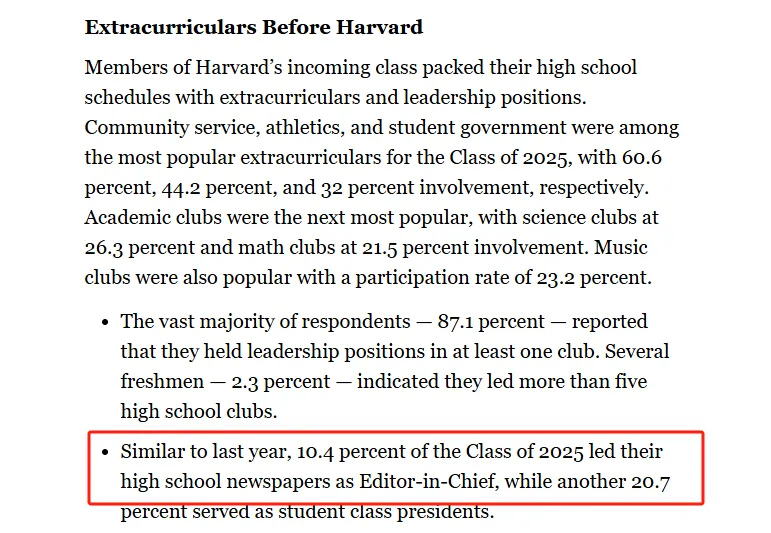85% of Aralia Students Place in Top Writing Competitions
What Harvard Freshman Surveys Reveal About Student Leadership and Journalism
The official student newspaper of Harvard University, The Harvard Crimson, conducts an annual survey of incoming freshmen to learn more about their backgrounds, interests, and academic passions.
The chart below is from the 2021 survey, which revealed that 87% of Harvard freshmen held at least one leadership position in a club or organization. In addition, around 10% served as editor-in-chief of their high school newspaper.

The 2023 freshman survey found that 23% of Harvard freshmen had participated in journalism-related extracurricular activities. These numbers tell us one thing: if you’re considering which extracurriculars to pursue in high school, becoming an editor for your school newspaper is a great option!
What Is a High School Newspaper?
A high school newspaper is more than just a student publication—it’s a platform for student voices, a training ground for future leaders, and a vital part of school culture. Many high schools offer students the opportunity to create and manage their own school newspaper. These publications are typically student-run, with faculty serving only as advisors, allowing students to take full ownership of the editorial process.
At its core, a school newspaper covers the events, issues, and interests that matter to the student body and the broader school community. Common coverage includes:
- Campus News and Community Reporting: Updates on school events, administrative changes, and local events affecting students and staff.
- Achievements and Awards: Spotlights on academic, athletic, or artistic accomplishments by students, teachers, or the school.
- Club and Sports Team Coverage: Features covering student organizations, sports teams, competitions, and performances.
- Interviews: Conversations with new students, faculty members, or distinguished alumni that bring fresh perspectives into the community.
- Advice Columns and Opinion Pieces: Student perspectives on study habits, course selection, school life, and broader societal issues.
- Arts and Culture Reviews: Critiques and discussions of books, films, music, and trending media that reflect student interests.
Some of the most prestigious U.S. high schools, including Groton School (The Circle Voice), Deerfield Academy (The Deerfield Scroll), and Choate Rosemary Hall (The Choate News), have long-standing student newspapers that uphold high journalistic standards. These periodicals are often regarded among the most formative and prestigious extracurriculars available to students.
What sets the school newspaper apart from other clubs is the freedom and responsibility it grants students. Writers, editors, designers, and photographers must collaborate under real deadlines, exercise editorial judgment, and maintain integrity in their reporting. This independence nurtures critical thinking, creativity, and confidence—all highly transferable skills valued in university admissions and beyond.
Typical Roles at a High School Newspaper: An In-Depth Look
Some high schools offer journalism courses, where students can participate in the school newspaper during the school day and earn academic credits. Other schools treat the newspaper as an extracurricular activity, meaning students can use their time after school to participate. Regardless of the structure, working on a school newspaper requires a significant time commitment, making it a demanding but rewarding activity.
Overall, the roles within a school newspaper can vary depending on each school’s priorities. Still, most high schools provide opportunities for students to work in key areas of content creation, design, and editorial direction. Let’s explore these roles in greater detail!
Want to Improve Your GPA in Middle School or High School?
1. Journalist/Writer
- Journalists are the backbone of any school newspaper. They gather information, conduct interviews, research stories, and write articles.
- Writers are often assigned stories based on their interests, current events at school, or themes the editorial team decides to cover for each issue.
- New members typically start as journalists, which allows them to learn the foundational skills of writing, researching, and editing while also getting familiar with the publication process.
2. Editor
- As students gain more experience, they can take on an editor role. Editors oversee the work of the journalists, ensuring that articles meet the newspaper’s standards for quality, accuracy, and style.
- Editors work closely with writers to provide constructive feedback, suggest revisions, and guide them in honing their writing. They also ensure that articles are fact-checked and polished before publication.
- Editors often participate in brainstorming sessions to develop story ideas, plan editorial themes, and prioritize coverage for each newspaper issue. Their work is essential in ensuring a consistent voice and tone throughout the publication.
3. Editor-in-Chief
- The Editor-in-Chief is the highest-ranking editorial position in a school newspaper. This role involves overseeing the entire publication process from start to finish. The Editor-in-Chief makes final decisions on editorial content, story selection, and the newspaper’s overall direction.
- Additionally, they often act as the liaison between the newspaper staff and the faculty advisor. The Editor-in-Chief also manages editorial meetings and calendars and helps set the vision for the paper.
4. Layout and Design
- The layout and design team is responsible for the newspaper’s visual presentation. Members of this team might work as graphic designers, photographers, or page editors. They create the overall look of the publication, ensuring that images, headlines, and stories are well-balanced on each page. The team collaborates closely with editors to guarantee the design complements the editorial content.
5. Social Media Manager
- In today’s digital age, social media is critical in school newspaper distribution and promotion. Social media managers manage the newspaper’s online presence on platforms like Instagram, Twitter, and Facebook.
- The social media manager may also help design digital advertisements and contribute to digital marketing efforts to attract readers and increase engagement.
6. Other Roles
- Copy Editors: Ensuring articles are grammatically correct, clear, and concise.
- Advertising Manager: Securing ads for the paper to generate revenue for printing and other expenses.
- Event Coverage Team: Specialized reporters focused on covering specific events, such as sports games, school performances, or community outreach activities.
Each of these roles plays a vital part in the functioning of a school newspaper, providing students with opportunities to develop diverse skills.
How Can School Newspaper Activities Assist with College Applications?
Showcasing Academic Ability: Involvement in a school newspaper can provide a platform for students to develop and showcase a wide range of academic skills. Writing for a school newspaper often involves research, crafting compelling narratives, interviewing, and analyzing events. Whether students are writing news reports, op-eds, or feature stories, they demonstrate their ability to engage with complex topics and express ideas clearly and persuasively.
Top universities strongly emphasize academic writing and communication skills. For students aiming to stand out in their college applications, submitting previously published newspaper pieces can serve as an excellent supplement to their personal statements and academic records. These works highlight writing proficiency, the ability to think critically, and engagement with pressing societal issues, all highly valued in college admissions.
Demonstrating Leadership and Influence: Leadership is one of the most sought-after qualities in college applicants. Serving in key leadership roles within the school newspaper, such as Editor-in-Chief, provides students with an opportunity to demonstrate their leadership and organizational skills meaningfully. These positions require students to coordinate a team of writers, assign stories, oversee editorial processes, and ensure deadlines are met.
Furthermore, the influence students can wield through their work in the school newspaper is another critical factor in college applications. A student-led investigative report or an editorial piece that sparks campus-wide conversations about important issues showcases the student’s ability to lead and influence others. By working with their school newspaper, students can impact the wider world. This aligns with the values of many elite universities, which seek academically capable and motivated students to make a difference in their communities.
Highlight your Competitive Edge with Unique Experience: Participation in a school newspaper can be a unique differentiator for students applying to college, particularly when it is combined with other academic interests. For example, students passionate about STEM fields might use their role in the school newspaper to explore the intersection of science, technology, and society. By contributing articles covering topics like the ethical implications of new technologies or the importance of STEM education, students can demonstrate their ability to think critically across disciplines and engage in various intellectual pursuits.
In recent years, data journalism has become a niche but growing field that offers opportunities for students to blend their analytical skills with their passion for storytelling. By utilizing data sets to analyze trends or explore social issues, students can demonstrate their ability to synthesize information from multiple sources and present it in an engaging and informative way. This type of interdisciplinary work sets students apart from their peers and demonstrates their capacity to bridge the gap between technical skills and creative communication.
Building Strong Recommendation Letters and Networking: One of the often-overlooked benefits of working for a school newspaper is building strong relationships with teachers and mentors who can later provide recommendation letters for college applications. In many schools, the newspaper advisor is a teacher, often in the humanities or social sciences, who provides guidance on writing, editing, and story development. Building a rapport with this advisor through dedicated work on the newspaper can lead to a recommendation letter highlighting the student’s intellectual curiosity, work ethic, and ability to collaborate effectively. These relationships can translate into powerful letters of recommendation, as teachers will have firsthand knowledge of the student’s leadership abilities, writing talents, and commitment to producing quality work.
Additionally, working on the school newspaper can provide networking opportunities with alumni, local journalists, and other professionals who may offer valuable advice or connections. For example, if a student interviews a prominent alumnus for a feature story, they may be able to establish a lasting relationship with that individual. Such connections can later prove valuable when seeking internships, job opportunities, or further mentorship, giving students access to a network of professionals in their field.
Leveraging External Recognition, Such as International Competitions: Once students have gained substantial writing and editorial experience through their work with the school newspaper, they can further bolster their college applications by entering national and international writing competitions. These competitions, such as The New York Times Editorial Writing Competition and Scholastic Art & Writing Awards, allow students to demonstrate their writing prowess and receive recognition for their work. Winning or placing in such competitions adds credibility to a student’s application, proving that their work has been evaluated and acknowledged by external experts in the field.
Furthermore, if a student’s article receives attention beyond the school, such as being republished by a local news outlet or gaining recognition from professional journalists, this can serve as another form of external validation. Having an article that garners attention outside the school newspaper, particularly if it is linked to important community issues or reflects a unique perspective, demonstrates the student’s ability to engage with a broader audience and reinforces their potential to make a lasting impact.
How to Successfully Join a School Newspaper: A Detailed Guide
Now that we’ve explored the many benefits of being involved in a school newspaper, let’s dive into the steps you can take to join one successfully. This process may vary slightly depending on the school, but these general guidelines give you a clear path to follow.
The first step in joining any school newspaper is to contact the faculty advisor. This teacher is responsible for overseeing the newspaper and ensuring that its operation runs smoothly.
- Find the Right Contact: Look for the advisor’s contact details, typically available on your school’s website, or ask around in the school’s main office.
- Initiate Contact: Once you have the advisor’s contact information, reach out via email or in person. Be polite, express your interest in joining, and ask about any necessary steps to apply. Mention your enthusiasm for writing and desire to contribute to the school’s newspaper.
Keep in mind that some school newspapers may request that you submit a writing sample before joining. This helps the advisors assess your writing skills and determine where you might fit in the newspaper’s structure, whether as a reporter, editor, or in another role.
- Use Past Work: If you’ve already written essays, research papers, or any written content in class, you can use these pieces as your writing sample. Choose something that showcases your ability to articulate ideas clearly and logically.
- Write a Mock Article: If you don’t have a writing sample readily available or prefer to create something more relevant to the newspaper’s work, consider writing a mock article. Choose a school event, local news story, or interesting topic related to your school community and craft a well-structured piece that mimics the style of journalism.
Start with Smaller Roles or Tasks
Once you’re officially part of the school newspaper team, you’ll likely start with smaller tasks, such as writing shorter articles, contributing to the newspaper’s social media channels, or helping with research. These tasks allow you to build your skills gradually and familiarize yourself with the workflow.
If you see a gap or an area where you can contribute, don’t hesitate to volunteer for tasks or propose new ideas. Showing initiative is a key trait that can help you advance.
Joining a school newspaper can be an exciting and rewarding experience through which you develop valuable writing, leadership, and communication skills. Whether you’re starting as a reporter or aspire to be editor-in-chief, the skills you gain from this experience will serve you well in your future academic and professional endeavors.
Join Aralia's Creating a Digital Literary Magazine Workshop
In this course, students will learn how to create, publish, and lead an online literary magazine from start to finish. This includes developing a brand identity and name, advertising a call for submissions, managing incoming submissions, and selecting pieces for publication. Students will also practice proofreading and copy-editing, as well as designing, building, and launching a digital magazine using free website platforms.

Creating a Digital Literary Magazine Workshop
Create your own digital literary magazine! Learn editing, design, leadership, and publishing skills while building a standout writing portfolio.










